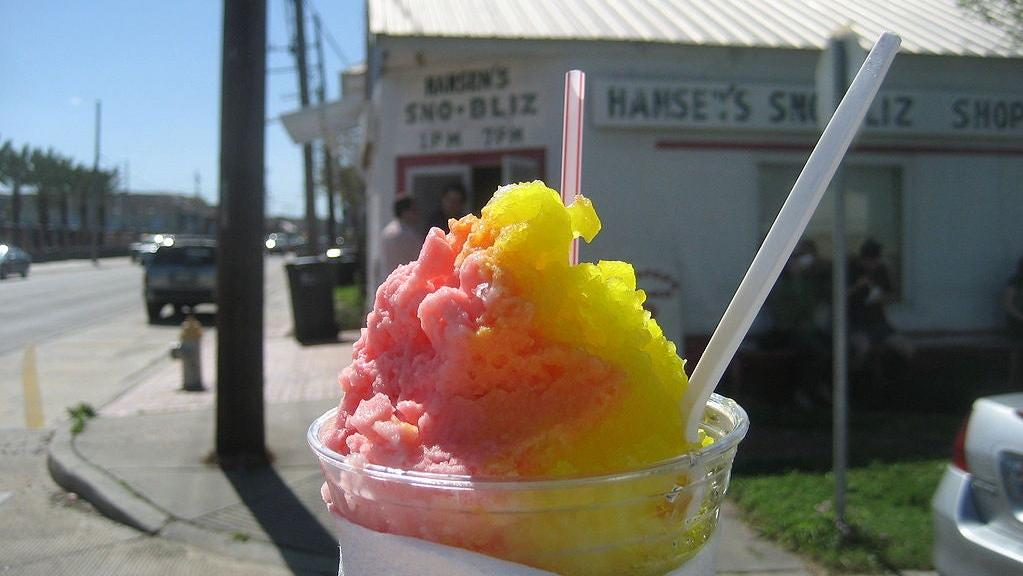The New Orleans Sno-Ball Is The Best End-Of-Summer Medicine
The regional shaved ice delight is among the city's best desserts.
From the humble tri-colored snow cone to halo-halo, many different types of frozen desserts exist at the nexus of shaved ice and sweets. And if there was ever a time for shaved ice, it's now—soon the gray clouds of winter will come for all of us, and shaved ice will fade into seasonal uselessness.
Now, I don't tend to spring for a shaved ice; usually a shaved ice will find me. One especially hot weekend this summer, delirious, shirt soaked in sweat, I happened upon a sno-ball truck here in Los Angeles, like manna from heaven.
What is a sno-ball?
The New Orleans–style sno-ball is one of the most ideal forms a shaved ice can take: the ice is finely shaved, forming an immaculately smooth texture that is covered in gorgeous sweet syrups and condensed milk. Sno-balls are part of New Orleans' rich food history, though they aren't as famous as the city's other desserts like beignets, pralines, or king cake, or even its other ice-based beverages like daiquiris.
When I got to the New Orleans Sno-Ball truck, there was one flavor I remembered from my time in NOLA. Hiding in plain sight is a flavor that is well-known in the Crescent City but not nationally: nectar. My provocation worked—when I ordered, the man serving me smiled.
"You from New Orleans?" he asked.
I can't claim to be a New Orleanian; I only went to school there. But I still knew that "nectar" acted like a password.
This is what's known as a shibboleth, or some type of knowledge (most commonly the pronunciation of certain words) that differentiates an in-group from everyone else. One well-known example of a shibboleth is in Inglourious Basterds, when Michael Fassbender's undercover Lt. Hicox is discovered as being Not German when he orders beer Not Germanically.
It is not surprising that if you look up the word "shibboleth" online, the accompanying image on the term's Wikipedia entry is sourced from New Orleans—go ahead and try to pronounce "Tchoupitoulas." Still, connecting with other New Orleanians about sno-balls is a joy, and with precious few days of summer left, the sno-ball deserves its glory as a top-tier summer refreshment for everyone to savor.
What makes New Orleans sno-balls so good
If a big chunk of ice flavored with watered-down juices doesn't interest you, then buddy, get in line. Sno-balls aren't that. The sno-ball is finely and mechanically shaved, to the point where it's almost unrecognizable as ice. It's fluffy and "snow"-like, a delight to eat, the type of food where each bite makes you gasp.
The ice is only matched by the sheer variety of vibrant syrups. To look at a menu of sno-ball flavors is to look at a beautiful rainbow, a world of sugar-dense, customizable possibility.
According to the Southern Foodways Alliance, which has a great series of interviews on Sno-Ball culture, "New Orleans' flavored ice tradition dates back to a time when vendors shaved the ice by hand and carried just a small selection of flavorings." Then in the 1930s, two New Orleans men invented shaving machines.
One of the oldest running stands is Hansen's Sno-Bliz, on Tchoupitouas Street as it happens. Ernest Hansen, "a machinist by trade and an inveterate tinkerer," invented a machine so he could make sno-balls for his kids. The eventual store was a New Orleans staple and remains one to this day. You don't see too many American success stories these days with a patriarch named Ernest. The other early entrant to the ice machine game was George Ortolano, inventing the "SnoWizard," and he gets a 10/10 for the name alone.
Outside of New Orleans, there isn't as much recognition for what a sno-ball is or can be. Many who don't know its intricacies perceive it as simply a snow cone.
"The biggest challenge is educating the public on what a sno-ball is and how it differs from a snow cone," said Kevyn Lee, who started Fluffy's Sno-Balls in Long Beach, California. "Once they try our product they are instantly in awe by the richness of flavor and smoothness of ice."
What’s the “nectar” sno-ball flavor?
It's an enticing name on the board, that's for sure. But nectar has its roots in a New Orleans food all its own: nectar-flavored soda, which was a big deal back when soda fountains were a thing. Luckily the flavor, a mix of vanilla and fruit so perfect it can induce the feeling that God is alive and real, managed to make it to sno-ball stands.
Did New Orleans or Baltimore invent the sno-ball?
The sno-ball is considered a regional treat in both New Orleans and Baltimore. Both cities have a lot in common, and sno-balls are just one example. Both are port cities. Both have a majority Black population. Both are known for their seafood and have specific spice mixes that are tantamount to holy. And above all, both cities hold a deep sense of pride in their communities. The differences lie in the details: Whereas nectar and wedding cake are the local flavor favorites in New Orleans, the old favorite in Baltimore is egg custard.
While the sno-ball is a staple of both cities' food scenes, Baltimore was actually first to the icy treat, according to Preservation Maryland. Both originated with hand-shaved vendors, but Baltimore opened its first shop almost a decade before New Orleans. Notably, Baltimore "snowballs" are spelled differently from New Orleans' "sno-balls."
Regardless of its origins, let's celebrate the fact that the sno-ball is a warm-weather treat around which multiple cities have formed their culinary identity. Really, more cities should. Everyone deserves their own delicious shibboleth.
